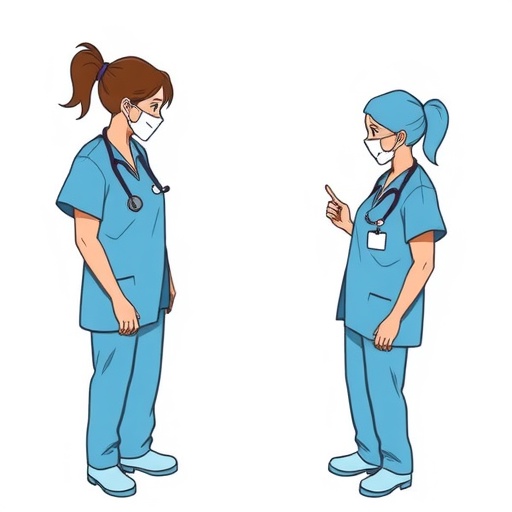In the ever-evolving landscape of healthcare, a recent study sheds light on the critical intersection of patient safety competency and patient safety culture specifically within primary care nursing. Published in the esteemed journal BMC Nursing, the research conducted by Wang et al. serves as a pivotal contribution to understanding how these two essential elements interact and influence one another. As we navigate the complexities of patient care, acknowledging the roles that competency and culture play in maintaining safety standards is paramount to enhancing patient outcomes.
The study reveals that patient safety is increasingly becoming a paramount concern in modern healthcare, especially in primary care settings where nurses often serve as the first line of defense against potential errors. The researchers utilized a novel network analysis framework to intricately map out the relationships between various competencies possessed by nursing professionals and the overarching safety culture within their working environments. By harnessing advanced analytical techniques, the authors could visualize a comprehensive overview of how different competencies are linked and how they collectively impact safety culture.
One of the fundamental findings of this research lies in the identification of key competencies that are critical for promoting patient safety. These competencies encompass a range of skills and knowledge that nurses must possess to effectively manage safety-related challenges in their daily practice. By delineating these competencies, the study underscores the importance of ongoing education and training for nursing professionals. The implications of these findings suggest that bolstering these competencies through targeted programs could significantly enhance the quality of patient care.
Moreover, the concept of patient safety culture is explored in depth in the study, emphasizing how organizational values, beliefs, and behaviors shape the perception and practice of safety among healthcare professionals. The research highlights that a strong safety culture fosters an environment where nurses feel empowered to report incidents, share concerns, and engage in open communication. This cultural framework not only impacts the individual nurse’s approach to patient care but also ripples out to influence the entire healthcare team’s dynamics, ultimately affecting patient outcomes.
The study’s network analysis uncovers intricate relationships among competencies and safety culture dimensions. For instance, it identifies that communication skills are not only pivotal in ensuring accurate patient information transfer but also play a crucial role in nurturing a culture of safety. Nurses equipped with strong communication skills can articulate safety concerns more effectively, thereby mitigating the risks associated with miscommunication, which is a common pitfall in healthcare settings.
Additionally, the research highlights the significance of leadership within the context of patient safety culture. Effective leadership can cultivate an environment of trust and accountability, where nurses feel encouraged to speak up about safety issues. The study posits that leadership styles that prioritize transparency and support foster a proactive safety culture, which is essential for minimizing risks and adverse events in patient care.
Furthermore, the findings of Wang et al. hold important implications for healthcare policymakers and administrators. As organizations strive to improve patient safety, utilizing the insights from this research can inform the development of robust policies aimed at enhancing both nursing competencies and the underlying safety culture. Integrating these elements into strategic planning can create a sustainable framework for continuous improvement in patient care practices.
Interestingly, as healthcare systems around the world face mounting pressures from increasing patient loads and resource constraints, prioritizing patient safety has never been more critical. The study elucidates that by investing in nurse training programs focused on patient safety competencies, healthcare organizations can not only bolster the skills of their workforce but also instill a strong culture of safety that resonates throughout the institution.
In conclusion, the network analysis presented by Wang et al. offers a compelling narrative about the interplay between patient safety competencies and culture among primary care nurses. The insights gleaned from this research provide a roadmap for enhancing patient safety initiatives in healthcare settings, emphasizing a multifaceted approach that integrates education, culture, and leadership. As we continue to seek improvement in patient safety outcomes, the call to action is clear: fostering a robust safety culture through the development of essential nursing competencies is not merely an option but an imperative in today’s complex healthcare landscape.
This pivotal study not only contributes valuable knowledge to the field of nursing but also serves as a critical reminder of the profound impact that healthcare professionals can have on patient safety when equipped with the right tools and supports. As we advance, let us be guided by the principles underscored in this research—ensuring that patient safety is at the forefront of our collective efforts in delivering exceptional care.
Subject of Research: Patient Safety Competency and Culture among Primary Care Nurses
Article Title: Network analysis of patient safety competency and patient safety culture among primary care nurses
Article References: Wang, C., Sun, B., Shi, H. et al. Network analysis of patient safety competency and patient safety culture among primary care nurses. BMC Nurs (2025). https://doi.org/10.1186/s12912-025-04120-7
Image Credits: AI Generated
DOI: 10.1186/s12912-025-04120-7
Keywords: Patient safety, primary care, nursing competencies, safety culture, healthcare leadership




